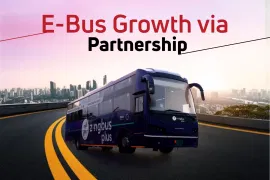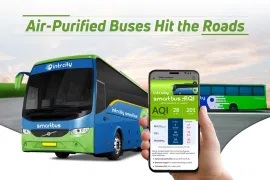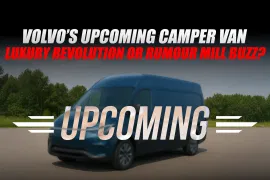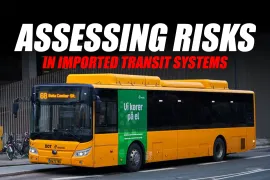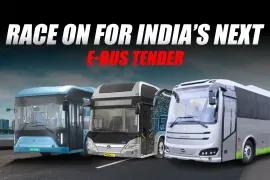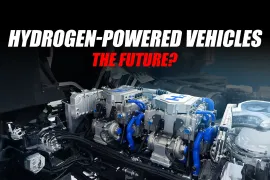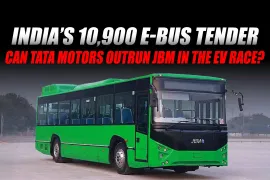Delhi's public transit has undergone a lot of transformation in the past decade. The Delhi Transport Corporation (DTC) has a group of CNG, diesel, and electric buses, running millions of individuals on a daily basis. Each bus helps maintain the city gridlocked in a secure, efficient, and long-lasting way. DTC facilitates easy movement of people, employees, and students around the capital, from local roads to inter-city freeways.
The article provides a total overview of the various types and names of DTC buses, their fares, operation, infrastructure, and impact on India's commercial transport industry as a whole.
How DTC’s Fleet Has Evolved
As of July, DTC operates over 7,600 buses, a major shift from the old diesel and CNG fleets. To meet Delhi’s transport demand, the corporation targets 5,500 CNG buses but currently runs only 3,762. Of the total fleet under DTC and the Cluster Scheme, nearly 3,000 CNG units are over 10 years old. This aging fleet causes frequent disruptions, with traffic police reporting that about 70 buses break down daily. The numbers highlight why Delhi urgently needs newer CNG and electric buses. The concept here is not just to create additional space; it is also to improve the experience for commuters and have a smaller impact on the environment.
- 12-Metre Electric Buses: Tata Motors is the principal company which manufactures these 12-meter electric buses. They are low floor, air conditioned and have an automatic gearbox. They are comfortable to travel in due to their ergonomic design, particularly for long city trips. There are presently 1,500 units operating in the city on a 12-year lease. They are the most critical part of Delhi's electric fleet.
- 9-Metre Electric Buses (DEVI): They are small, quick, and easy to maneuver through cities. They are great for reaching the last mile. They have GPS, CCTV cameras, and panic buttons which make it more secure for individuals to travel by bus and make things run more smoothly.
- Inter-State Electric Buses: DTC expanded beyond Delhi to link the city with 17 other cities in seven states. By reducing emissions and improving regional connectivity, Inter-State Electric Buses have made the journey smoother, cleaner, and greener.
This fleet change aligns with DTC's two main objectives: ensuring individuals who use public transit are comfortable and ensuring the environment is preserved for both intracity and intercity transportation requirements.

DTC Bus Brands and Models
DTC collaborates with top commercial vehicle manufacturers in India to maintain its fleet updated and reliable.
Electric buses
Electric buses are the most significant part of DTC's green transport plan presently since they are efficient as well as eco-friendly.
Tata Motors
- Tata Starbus Urban 9m and 12m: These air-conditioned low-floor buses are ideal for high-density city routes. They are equipped with automatic transmissions, power steering, and sophisticated safety equipment to provide safe and smooth rides.
Olectra Greentech (BYD frame)
- Olectra C9: The best mode of transportation to cover long distances with less pollution is by intercity bus.
- K9: The city's main bus line, which is frequently employed to cover around quickly.
- K7: A mini fast bus that can comfortably ride through crowded city roads and link to the last mile.
BYD India
- K9: They are normally utilized on city routes where traffic congestion is a common occurrence because they are meant to make journeys more effective and reduce pollution.
Ashok Leyland
- Ashok Leyland’s Circuit S: The route is perfect for commuting in the city and between cities, and it's also environmentally friendly.
JBM Group
- JBM ECO-LIFE Electric: Excellent for traveling around the city, even in heavy traffic.
Diesel and CNG buses
Although electric buses are gaining traction, we still require regular buses for peak hour travel and high frequency services.
- Ashok Leyland Viking Series: These buses are helpful for traveling around cities as well as between cities.
- Tata Starbus Diesel: durable, dependable, and commonly used in cities.
- Leyland Tiger: It is loved for being strong and long-lasting. It is primarily used to drive between cities and states.
More and more people are adopting electric buses, but these CNG and diesel buses always take you to where you have to go in the city.
Pricing and Operational Insights
Riders and fleet managers must understand how much buses cost and perform.
- Electric AC Low-Floor Buses: They cost around ₹110 per km and are costlier to operate and maintain than regular buses.
- Special Hire Rates: DTC leases buses under short-term contracts, film shootings, and tourism. This optimizes the use of the fleet and brings in additional money.
- Operational Model: This implies that there are private companies supplying drivers and DTC maintains conductors.
This keeps individuals employed and gets things moving more efficiently.
Improved technology and infrastructure
DTC continues investing in its infrastructure to maintain its new fleet:
- Electric Vehicle Charging Stations: Large bus termini such as Rajghat ensure buses operate efficiently by installing charging stations that are specifically designed for them.
- Intelligent Ticketing: UPI and card-based trials reduce cash usage and accelerate boarding.
- Bus Queue Shelters (BQS): The shelters include benches, LED display boards, and solar panels to ensure that commuters are comfortable, things are simplified, and commuters are secure.
DTC is enhancing public transport through the application of technology and people-focused design in these initiatives.
Environmental and Social Impact
Electric buses not only reduce pollution, but they also transform the way individuals move around in Delhi.
- Environmental Advantages: Cleaner air and less noise on streets make cities more livable.
- Accessibility: Safety features such as emergency stops and low-floor buses ensure that all members of society, including the disabled and the elderly, can travel safely.
- Inclusiveness: Initiatives such as pink cards allow women and transgender people to travel on public transport for free, ensuring that everyone is able to board.
The fleet demonstrates DTC's intention to socially responsible transport through the integration of environmental sustainability, openness, and effective performance.
The Future Of DTC
DTC desires to:
- The fleet will have 8,000 electric buses by 2025.
- IIT Delhi's route optimization will reduce wait times and coverage larger.
- Implement real-time tracking, automatic fare collection, and predictive maintenance to improve the operations.
- Ensure that all, including those outside the mainstream, can get access to transport that is safe, affordable, and convenient.
These factors make DTC the best company in India for green city transport and commercial buses.
Conclusion
DTC buses in 2025 demonstrate that Delhi is committed to public transportation that is modern, efficient, and environmentally friendly. The Tata Starbus, Olectra C9, BYD K9, Ashok Leyland Circuit S, and JBM ECO-LIFE are all vehicles that represent reliability, comfort, and tech advancement. DTC remains the best organisation in India for city buses and commercial buses. They possess up-to-date infrastructure, effective fleet maintenance, and regulations that everyone can adhere to.
For more articles and news, stay updated with 91trucks. Subscribe to our YouTube channel and follow us on Facebook, Instagram, and LinkedIn for the latest videos and updates from the automotive world!
Web Stories
Latest Buses News
Categories
91trucks is a rapidly growing digital platform that offers the latest updates and comprehensive information about the commercial vehicle industry.

